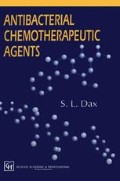Abstract
One of the most promising and vigorously pursued areas of contemporary anti-infective chemotherapy is that of the quinolone antibacterials. Broad spectrum, potent activity is available from a relatively simple molecular nucleus which is amenable to many structural modifications. Unlike antibiotics which originate from a natural source such as a fungi or a mold, the quinolone antibacterials are purely synthetic in origin.
Access this chapter
Tax calculation will be finalised at checkout
Purchases are for personal use only
Preview
Unable to display preview. Download preview PDF.
Further reading
C. Siporin, C.L. Heifetz and J.M. Domagala (Eds) (1990)The New Generation of Quinolones Marcel Dekker, New York.
J.S. Wolfson and D.C. Hooper (Eds) (1989)The Quinolones American Society for Microbiology, Washington, D.C.
V.T. Andriole (Ed.) (1988)The Quinolones Academic Press, San Diego, CA.
N.R. Cozzarelli and J.C. Wang (Eds) (1990)DNA Topology and Its Biological EffectsCold Spring Harbor Laboratory Press, Cold Spring Harbor, NY.
H. Neu (1992) ‘Quinolone antibacterial agents’,Annu. Rev. Med. 43465.
D.C. Hooper and J.S. Wolfson (1991) ‘Fluoroquinolone antimicrobial agents’,New England J. Med. 324384.
D.T.W. Chu and P.B. Fernandes (1990) ‘Quinolone antibacterial agents’, inAdvances in Drug ResearchVol. 21, B. Testa (Ed.) Academic Press, New York, pp. 42–144.
S. Radl (1990) ‘Structure-Activity Relationships in DNA Gyrase Inhibitors’,Pharm. Ther. 48, 1.
D.T.W. Chu and P.B. Fernandes (1989) ‘Structure-activity relationships of the fluoroquinolones’,Antimicrob. Agents Chemother. 33131.
S. Radl and D. Bouzard (1992) ‘Recent Advances in the Synthesis of Antibacterial Quinolones’,Heterocycles 342143.
R. Albrecht (1977) ‘Development of antibacterial agents of the nalidixic acid type’,Prog. Drug Res. 219.
J.C. Wang (1985) ‘DNA topoisomerases’,Annu. Rev. Biochem. 54665.
K. Drlica (1984) ‘Biology of bacterial deoxyribonucleic acid topoisomerases’,Microbiol. Rev. 48273.
N. Cozzarelli (1980) ‘DNA gyrase and the supercoiling of DNA’,Science 207953.
M. Geliert (1981) ‘DNA topoisomerases’,Annu. Rev. Biochem. 50879.
L.L. Shen, L.A. Mitscher, P.N. Sharma, J.J. O’Donnell, D.W.T. Chu, CS. Copper, T. Rosen and A.G. Pernet (1989) ‘Mechanism of inhibition of DNA gyrase by quinolone antibacterials: a cooperative drug-DNA binding model’,Biochemistry 283886.
L.A. Mitscher, B.D. Davis, T. Ichikawa and K. Maeda (1987) ‘Horizons on antibiotic research’ fromProceedings of the Symposium Dedicated to the Late Professor Hamao Umezawa on the 25th and 40th Anniversary of the Institute of Microbial Chemistry and the Japan Antibiotics Research AssociationNov. 25–26, Tokyo, Japan, 166–193.
D.C. Hooper and J.S. Wolfson (1988) ‘Mode of action of the quinolone antimicrobial agents’,Rev. Infectious Diseases 10(S1), S14.
J.S. Wolfson and D.C. Hooper (1985) ‘The fluoroquinolones: structures, mechanisms of action and resistance, and spectra of activityin vitro’ Antimicrob. Agents Chemother. 28, 581.
L.L. Shen and A.G. Pernet (1985) ‘Mechanism of inhibition of DNA gyrase by analogues of nalidixic acid: the target of the drugs is DNA’,Proc. Natl. Acad. Sei. USA 82307.
D.S. Horowitz and J.C. Wang (1987) ‘Mapping the active site tyrosine ofEscherichia coliDNA gyrase’,J. Biol. Chem. 2625339.
C.J.R. Willmott and A. Maxwell (1993) ‘A single point mutation in the DNA gyrase A protein greatly reduces binding of fluoroquinolones to the gyrase-DNA complex’Antimicrob. Agents Chemother. 37126.
G.W. Kaatz, S.M. Seo and CA. Ruble (1993) ‘Efflux-mediated fluoroquinolone resistance inStaphylococcus aureus’, Antimicrob. Agents Chemother. 371086.
D.B. Wigley, G.J. Davies, E.J. Dodson, A. Maxwell, and G. Dodson (1991) ‘Crystal structure of an N-terminal fragment of the DNA gyrase B protein,Nature 351624.
CD. Lima, J.C. Wang and A. Mondragon (1994) ‘Three-dimensional structure of the 67K N-terminal fragment of E. coli DNA topoisomerase I’,Nature 367138.
C.Hubschwerlen, P. Pflieger, J.-L. Specklin, K. Gubernator, H. Gmunder, P. Ahgehrn and I. Kompis (1992) ‘Pyrimido[l,6a]benzimidazoles: a new class of DNA gyrase inhibitors’,J. Med. Chem. 351385.
Author information
Authors and Affiliations
Rights and permissions
Copyright information
© 1997 Chapman & Hall
About this chapter
Cite this chapter
Dax, S.L. (1997). Quinolone antibacterials. In: Antibacterial Chemotherapeutic Agents. Springer, Dordrecht. https://doi.org/10.1007/978-94-009-0097-4_7
Download citation
DOI: https://doi.org/10.1007/978-94-009-0097-4_7
Publisher Name: Springer, Dordrecht
Print ISBN: 978-94-010-6531-3
Online ISBN: 978-94-009-0097-4
eBook Packages: Springer Book Archive

